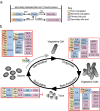Bile acids impact the microbiota, host, and C. difficile dynamics providing insight into mechanisms of efficacy of FMTs and microbiota-focused therapeutics
- PMID: 39224076
- PMCID: PMC11376424
- DOI: 10.1080/19490976.2024.2393766
Bile acids impact the microbiota, host, and C. difficile dynamics providing insight into mechanisms of efficacy of FMTs and microbiota-focused therapeutics
Erratum in
-
Correction.Gut Microbes. 2024 Jan-Dec;16(1):2411134. doi: 10.1080/19490976.2024.2411134. Epub 2024 Oct 3. Gut Microbes. 2024. PMID: 39361787 Free PMC article. No abstract available.
Abstract
Clostridioides difficile is a major nosocomial pathogen, causing significant morbidity and mortality worldwide. Antibiotic usage, a major risk factor for Clostridioides difficile infection (CDI), disrupts the gut microbiota, allowing C. difficile to proliferate and cause infection, and can often lead to recurrent CDI (rCDI). Fecal microbiota transplantation (FMT) and live biotherapeutic products (LBPs) have emerged as effective treatments for rCDI and aim to restore colonization resistance provided by a healthy gut microbiota. However, much is still unknown about the mechanisms mediating their success. Bile acids, extensively modified by gut microbes, affect C. difficile's germination, growth, and toxin production while also shaping the gut microbiota and influencing host immune responses. Additionally, microbial interactions, such as nutrient competition and cross-feeding, contribute to colonization resistance against C. difficile and may contribute to the success of microbiota-focused therapeutics. Bile acids as well as other microbial mediated interactions could have implications for other diseases being treated with microbiota-focused therapeutics. This review focuses on the intricate interplay between bile acid modifications, microbial ecology, and host responses with a focus on C. difficile, hoping to shed light on how to move forward with the development of new microbiota mediated therapeutic strategies to combat rCDI and other intestinal diseases.
Keywords: Clostridioides difficile; bile acids; fecal microbiota transplantation; microbiota; nuclear receptors; recurrent CDI.
Conflict of interest statement
C.M.T. consults for Vedanta Bioscicens, Inc., Summit Therapeutics, and Ferring Pharmaceuticals, Inc. and is on the Scientic Advisory Board for Ancilia Biosciences.
Figures

Similar articles
-
Metagenomic, metabolomic, and lipidomic shifts associated with fecal microbiota transplantation for recurrent Clostridioides difficile infection.mSphere. 2024 Oct 29;9(10):e0070624. doi: 10.1128/msphere.00706-24. Epub 2024 Oct 8. mSphere. 2024. PMID: 39377587 Free PMC article.
-
Understanding the mechanisms of efficacy of fecal microbiota transplant in treating recurrent Clostridioides difficile infection and beyond: the contribution of gut microbial-derived metabolites.Gut Microbes. 2020 Nov 9;12(1):1810531. doi: 10.1080/19490976.2020.1810531. Gut Microbes. 2020. PMID: 32893721 Free PMC article. Review.
-
The role of the gut microbiome in colonization resistance and recurrent Clostridioides difficile infection.Therap Adv Gastroenterol. 2022 Nov 18;15:17562848221134396. doi: 10.1177/17562848221134396. eCollection 2022. Therap Adv Gastroenterol. 2022. PMID: 36425405 Free PMC article. Review.
-
Microbial bile salt hydrolases mediate the efficacy of faecal microbiota transplant in the treatment of recurrent Clostridioides difficile infection.Gut. 2019 Oct;68(10):1791-1800. doi: 10.1136/gutjnl-2018-317842. Epub 2019 Feb 11. Gut. 2019. PMID: 30816855 Free PMC article.
-
Effective fecal microbiota transplantation for recurrent Clostridioides difficile infection in humans is associated with increased signalling in the bile acid-farnesoid X receptor-fibroblast growth factor pathway.Gut Microbes. 2019;10(2):142-148. doi: 10.1080/19490976.2018.1506667. Epub 2018 Sep 5. Gut Microbes. 2019. PMID: 30183484 Free PMC article.
Cited by
-
Suppressed intestinal secondary bile acids in moxifloxacin-induced hyperglycemia: studies in normal and diabetic GK rats.Front Pharmacol. 2025 Apr 4;16:1569856. doi: 10.3389/fphar.2025.1569856. eCollection 2025. Front Pharmacol. 2025. PMID: 40255568 Free PMC article.
-
Proton-pump inhibitors increase C. difficile infection risk by altering pH rather than by affecting the gut microbiome based on a bioreactor model.Gut Microbes. 2025 Dec;17(1):2519697. doi: 10.1080/19490976.2025.2519697. Epub 2025 Jun 16. Gut Microbes. 2025. PMID: 40524314 Free PMC article.
-
Clostridioides difficile toxins alter host metabolic pathway and bile acid homeostasis gene expression in colonic epithelium.Infect Immun. 2025 Aug 12;93(8):e0015025. doi: 10.1128/iai.00150-25. Epub 2025 Jun 30. Infect Immun. 2025. PMID: 40586821 Free PMC article.
-
Fecal Microbiota Transplantation (FMT) in Clostridium difficile Infection: A Paradigm Shift in Gastrointestinal Microbiome Modulation.Cureus. 2025 May 29;17(5):e85054. doi: 10.7759/cureus.85054. eCollection 2025 May. Cureus. 2025. PMID: 40585700 Free PMC article.
-
Ileal FXR Knockdown Ameliorates MASLD Progression in Rats via Modulating Bile Acid Metabolism Mediated by Gut Microbiota.J Gastroenterol Hepatol. 2025 Aug;40(8):2091-2103. doi: 10.1111/jgh.17017. Epub 2025 May 24. J Gastroenterol Hepatol. 2025. PMID: 40411313 Free PMC article.
References
-
- CDC . Antibiotic resistance threats in the United States, 2019. Atlanta (GA): U.S. Department of Health and Human Services, CDC; 2019.
-
- Theriot CM, Koenigsknecht MJ, Carlson PE, Hatton GE, Nelson AM, Li B, Huffnagle GB, Z. Li, J., Young VB. Antibiotic-induced shifts in the mouse gut microbiome and metabolome increase susceptibility to clostridium difficile infection. Nat Commun. 2014;5(1):3114. doi:10.1038/ncomms4114. - DOI - PMC - PubMed
-
- Johnson S, Lavergne V, Skinner AM, Gonzales-Luna AJ, Garey KW, Kelly CP, Wilcox MH. Clinical practice guideline by the infectious diseases society of America (IDSA) and society for healthcare epidemiology of America (SHEA): 2021 focused update guidelines on management of Clostridioides difficile infection in adults. Clin Infect Dis. 2021;73(5):e1029–e1044. doi:10.1093/cid/ciab549. - DOI - PubMed
Publication types
MeSH terms
Substances
Grants and funding
LinkOut - more resources
Full Text Sources
Molecular Biology Databases
